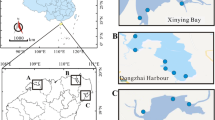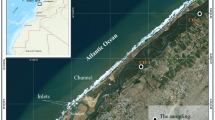Abstract
Purpose
The geochemistry of rare earth elements (REEs) taken from the sediments of a karst lake was analyzed to track the provenance of the sediments and the history of soil erosion in the Jiuzhaigou Nature Reserve (JNR) in Sichuan Province in southwest China.
Materials and methods
The REE concentrations of 177 samples including 150 lake sediments, 13 soils, 8 loess, 3 carbonate rocks, and 3 water were determined using a quadruple inductively coupled plasma mass spectrometer (Q-ICP-MS). The grain size distributions of 139 sediment samples were measured using a Malvern Master Size 2000 laser particle size analyzer. The carbonate contents of 159 sediment samples were determined using a gasometric method. The dried remains after reaction with HCl were defined as acid-insoluble residues. The mineral composition of the sediments was measured using a Philips X'Pert Pro X-ray diffractometer.
Results and discussion
The lake sediments in the JNR exhibit features similar to those of the neighboring soils, i.e., enriched REE content, a greater ratio of light REEs to heavy REEs, greater δCe values, and lower δEu values relative to those in the carbonate rocks. The REE signatures in the silt and sand fractions of the sediments are similar to those in the soils and carbonate rocks, respectively. The REE content, LREE/HREE, and δCe values in the sediments strongly negatively correlate with the carbonate content, indicating an intense carbonate effect on the REE geochemistry. The content of acid-insoluble residues is obviously positively correlated with ∑REEs in the sediments, and a negative relationship is observed between ∑REEs and the ratio of calcite to quartz in the sediments.
Conclusions
The sediments in the JNR originate from eroded soils and authigenic travertine deposits in the lakes. It is proposed that the increased ∑REEs in the sediments resulted from the elevated proportion of soil particles in lacustrine deposits was due to increasing soil erosion intensity. This hypothesis is evidenced by the coupling of ∑REEs with the intensity of soil erosion and anthropogenic activities in the JNR. In karst drainage, the total REE concentration might be a potentially powerful indicator for reconstructing the history of soil erosion.







Similar content being viewed by others
References
Balashov YA, Girin YP (1969) On reserve of mobile rare earth elements in sedimentary rocks. Geochem Int 6:649–658
Boynton WV (1984) Geochemistry of the rare earth elements: Meteorites studies. Elsevier Science Publishers, B. V., Amsterdam
Byrne RH, Kim KH (1993) Rare earth precipitation and coprecipitation behavior: The limiting role of PO4 3− on dissolved rare earth concentrations in seawater. Geochim Cosmochim Acta 57:519–526
Chen F (2009) An exploration for eco-tourism management in the Jiuzhaigou. Econ Res Guide 21:147–148 (in Chinese)
Guo SB (1993) Geography of historical agriculture in Sichuan. Sichuan People's Publishing House, Chengdu (in Chinese)
Guzmán G, Quinton JN, Nearing MA, Mabit L, Gómez JA (2013) Sediment tracers in water erosion studies: Current approaches and challenges. J Soil Sediment 13:816–833
Henderson P (1984) General geochemical properties and abundances of the rare earth elements. Elsevier, New York
Huang CM, Gong ZT (2001) Geochemical implication of rare earth elements in process of soil development. J Rare Earth 19:57–62
Knaus R, Van Gent D (1989) Accretion and canal impacts in a rapidly subsiding wetland III: a new soil horizon marker method for measuring recent accretion. Estuaries 12:269–283
Küster Y, Hetzel R, Krbetschek M, Tao M (2006) Holocene loess sedimentation along the Qilian Shan (China) significance for understanding the processes and timing of loess deposition. Quat Sci Rev 25:114–125
Lei GL, Zhang ZM, Wang CS, Yang ZL, Qi L, Qian ZX (1994) REE geochemistry of karst sediments in Guizhou province, China. Acta Geogr Sin 14:298–308 (in Chinese with English abstract)
Li JY, Zhu LJ, Chen Y (1998) Rare earth element distribution in weathering crusts of carbonate rocks, Guizhou Province, China. Carsologica Sin 17:15–24 (in Chinese with English abstract)
Liang KK, Hu XX, Li SG, Huang CM, Tang Y (2014) Sources of lake sediment and its deposition dynamics based on 137Cs and 210Pbex techniques in Jiuzhaigou Nature Reserve. Chin Geogr Sci 24:180–190
Liu J (2002) Modern opium trade and its harm in the Sichuan Tibetan region. China Tibetology 1:50–58 (in Chinese)
Liu TS (2009) Loess and arid environment. Anhui Science & Technology Publishing House, Hefei (in Chinese)
Liu PL, Tian JL, Zhou PH, Yang MY, Shi H (2004) Stable rare earth element tracers to evaluate soil erosion. Soil Till Res 76:147–155
Lv HL, Li YX, Chen XZ, Fan YG, Yang QX, Wang Y (2010) The Di settlement of the northwestern Sichuan Highlands in the Han Dynasty: a preliminary report and study Ashaonao Site, Jiuzhaigou National Park. J Tibetology 6:125–136 (in Chinese with English abstract)
Magee JW, Bowler JM, Miller GH, Williams DLG (1995) Stratigraphy, sedimentology, chronology and palaeohydrology of Quaternary lacustrine deposits at Madigan Gulf, Lake Eyre, south Australia. Palaeogeogr Palaeoclimatol 113:3–42
Polyakov VO, Nearing MA (2004) Rare earth element oxides for tracing sediment movement. Catena 55:255–276
Qi L, Hu J, Gregoire DC (2000) Determination of trace elements in granites by inductively coupled plasma mass spectrometry. Talanta 51:507–513
Qiao X (2012) The impacts of regional air pollution on the World Nature Heritage site, Jiuzhaigou National Reserve, southwestern China, Sichuan University. Ph Doctral desertation (in Chinese with English abstract)
Ran GR, Gongteng Y (1996) Historical culture in the upper region of Min river, Sichuan Province, China. Sichuan University Press, Chengdu (in Chinese)
Roberts HM, Wintle AG, Maher BA, Hu MY (2001) Holocene sediment-accumulation rates in the western Loess Plateau, China, and a 2500-year record of agricultural activity, revealed by OSL dating. The Holocene 11:477–483
Shi JA, Guo XL, Wang Q, Yan NZ, Xia WJ (2003) Geochemistry of REE in QH1 sediments of Qinghai Lake since late Holocene and its paleoclimatic significance. J Lake Sci 15:28–34 (in Chinese with English abstract)
The Team for Jiuzhai and Huanglong core scenic landscape water system and the ecological geological environment sustainable development of integrated application (2009) The Jiuzhai core scenic landscape water system and the ecological geological environment sustainable development of integrated application. University of Electronic Science and Technology Press, Chengdu (in Chinese with English Abstract)
Soil Survey Staff (1996) Soil survey field and laboratory methods manual. USDA, Washington
Song ZL, Liu CQ, Han GL, Wang ZL, Zhu ZZ, Yang C (2006) Enrichment and release of rare earth elements during weathering of sedimentary rocks in Wujiang Catchments, Southwest China. J Rare Earth 24:491–496
Steinmann M, Stille P (2006) Rare earth element transport and fractionation in small streams of a mixed basaltic–granitic catchment basin (Massif Central, France). J Geochem Explor 88:336–340
Stevens CJ, Quinton JN (2008) Investigating source areas of eroded sediments transported in concentrated overland flow using rare earth element tracers. Catena 74:31–36
Sun CX, Wang SJ, Ji HB (2002) Formation mechanism of the super high concentration of REE and the strong negative Ce anomalies in the carbonate rock weathering profiles in Guizhou Province, China. Geochimica 31:119–127 (in Chinese with English abstract)
Taylor SR, McLennan SM (1985) The Continental Crust: Its composition and evolution. Blackwell Scientific Publications, Oxford
Tian JL, Zhou PH, Liu PL (1994) REE tracer method for studies on soil erosion. Int J Sediment Res 9:39–46
Wu N, Yan ZL, Luo P, Liu J (2003) Acculturation diversity of ethnic cultures on the upper Minjiang river. J Mt Sci 21:16–23 (in Chinese with English abstract)
Xiao JL, Nakamura T, Lu HY, Zhang GY (2002) Holocene climate changes over the desert/loess transition of north-central China. Earth Planet Sci Lett 197:11–18
Yu X, Jiang CH (1984) Modern marine sedimentary mineral and its X-ray diffraction. Science Publishing House, Beijing (in Chinese)
Zhang XC, Nearing MA, Polyakov VO, Friedrich JM (2003) Using rare-earth oxide tracers for studying soil erosion dynamics. Soil Sci Soc Am J 67:279–288
Zhu MY, Tan SD, Liu WZ, Zhang QF (2010) A review of REE tracer method used in soil erosion studies. Agric Sci China 9:1167–1174
Zhu MY, Tan SD, Dang HS, Zhang QF (2011) Rare earth elements tracing the soil erosion processes on slope surface under natural rainfall. J Environ Radioact 102:1078–1084
Acknowledgments
This work was funded by the National Key Technologies R&D Project in China (No. 2012BAC06B02), the Program of Introducing Talents of Discipline to Universities (No. B08037), and the Natural Science Foundation for Doctoral Career of Mianyang Normal University (QD2013A08).
Author information
Authors and Affiliations
Corresponding author
Additional information
Responsible editor: Rainer Horn
Rights and permissions
About this article
Cite this article
Wen, XY., Huang, CM., Tang, Y. et al. Rare earth elements: a potential proxy for identifying the lacustrine sediment source and soil erosion intensity in karst areas. J Soils Sediments 14, 1693–1702 (2014). https://doi.org/10.1007/s11368-014-0928-y
Received:
Accepted:
Published:
Issue Date:
DOI: https://doi.org/10.1007/s11368-014-0928-y




